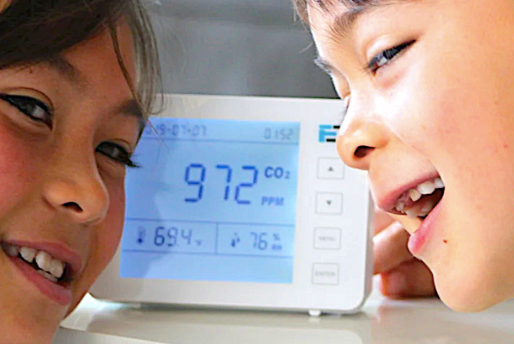Ecofriendly Classroom Features:
Lighting, Ventilation and
Climate Control
Ecofriendly classroom features include daylighting, high air quality, temperature control, and smart automation. Automating these features ensures that classroom occupants can focus on their learning while being as environmentally friendly — and healthy — as possible.

The larger task of education is to help expand our sense of ecological and human possibilities.... It is possible to construct buildings that promote ecological imagination and help to develop ecological competence.
— David Orr
1. Lighting:
- install light level sensors and electronic light monitors that collect and distribute natural light
- install devices to control light reflecting, shading and blocking
- install the best possible eco-friendly light fixtures: task-oriented, student-specific and teacher-specific, adjustable according to daylight and glare
- install operable, thermally efficient windows appropriate to solar orientation (consider reglazing if window replacement is too costly)
- on south-facing classroom windows, consider the use of light shelves and/or solar shading with automatic perimeter lighting to extend daylight into the classroom and to save electricity
2. Ventilation and air quality:
- appropriate ventilation that:
- reduces outside noise
- takes into account the maximum number of students using the classroom
- ensure constant flow of fresh air when classroom is occupied (some buildings use raised floors fitted with vents)
- plants in each classroom, for air quality improvement, humidification, and reduction in energy use
- quiet ceiling fans, windows that open (to save AC/air conditioning energy)
- CO2 monitor / sensor in each classroom (carbon dioxide gas level gives a good indication of air quality and virus infection risk)

3. Climate and temperature (consider staff offices, too):
- energy efficient heating and cooling systems
- design with solar orientation in mind to decrease the need for heating and cooling
- increase insulation
- plan for climate control within the space (considered optimal for teachers, as research shows that classroom temperature is more important to teachers than students)
- simple-to-operate temperature thermostat/climate control device in each classroom
- ensure that climate control is linked into Building Automation System so optimal settings can be prescribed (but overridden)
- window shades/blinds that let in appropriate amounts of heat and light (depending on season) for passive solar heating and shade cooling
- consider whether learning activities will result in heat generation by students in this classroom
- suggested comfortable temperature ranges: 68-72°F, or 61-74°F (16-23°C) if physical learning activities are taking place (consider that men's and boys' clothing traditionally insulates the body better than women's and girls' clothing)
4. Smart automation where possible ("smart" in assumptions re users' behaviours and needs) - aluminum sensors for automatic heating/cooling and lighting (door opens = lights and HVAC go on; windows open = HVAC goes off)
5. Appropriate location for recycling/composting bins
IDEAL
Each classroom contributes to a "building that teaches," that is, a facility "in which the lessons embodied in technology and design choices serve to reinforce rather than contradict lessons taught in its classrooms" (David Orr)
- fully accessible and labelled in-class monitoring and display system to track air quality and energy use
- "truth walls" in some classrooms to show how the building works
- make the classroom a pedagogical tool for teaching ecological principles and sustainability practices; "make the flows of energy and cycles of matter between the built and natural environments visible and easy to interpret" (David Orr)
- provide engaging real-time data/feedback on temperature, resource consumption and light levels in some classrooms, especially science and geography classrooms: "real-time feedback on ecological performance increases awareness, connectedness, and motivation to act" (David Orr)
- design classrooms that are sustainable, intelligent, universal, healthy, and culturally appropriate (from Institute Without Borders)
Return to Greening Facilities
Go to School Greening
Visit GreenHeart Education Homepage
|